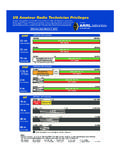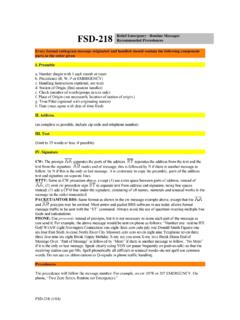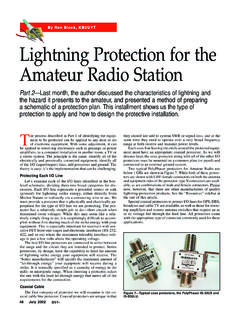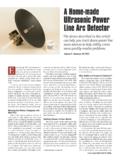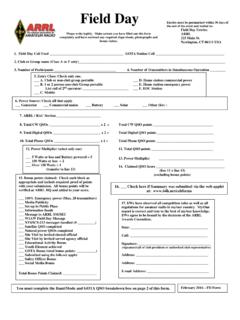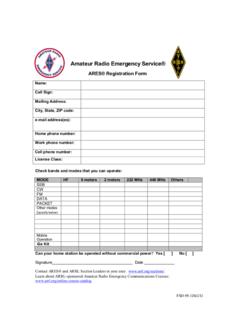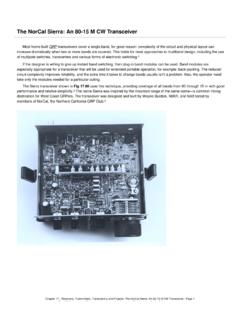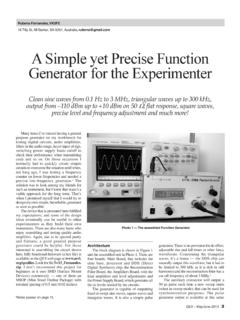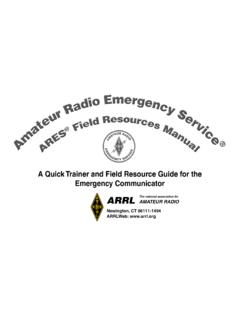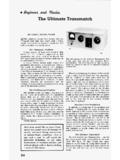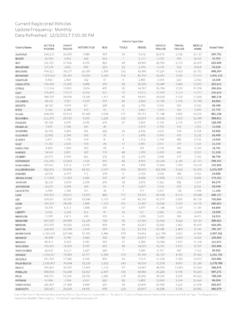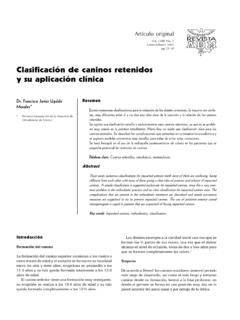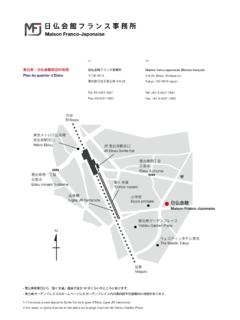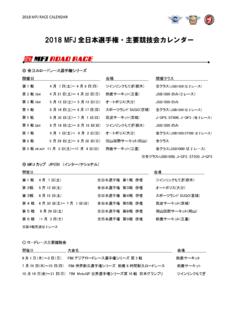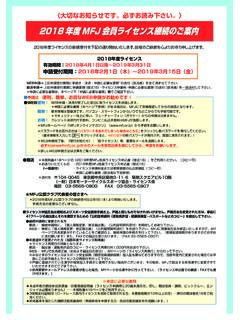Transcription of Measuring Cable Loss - American Radio Relay …
1 Measuring Cable loss Improving measurement accuracy when low-power analyzers are used. By Frank Witt, AI1H. T. he matched loss of a Cable Eq 29 on page 24-26 and Eq 35 on open cases. We can then find the with a characteristic impe- page 24-27 of The ARRL Antenna Cable loss (in decibels) from: dance, Z 0, is the loss of the Book, 19th and 20th editions, respec- Cable when it is terminated in Z0. A tively. well-publicized way of Measuring This method has two problems LC = 5 log S O. the matched loss of a Cable is to when the Measuring instrument is measure the magnitude of the reflec- a low-power analyzer like the MFJ SWRS + 1 SWRO + 1.
2 Tion coefficient, | |, SWR, or return Model MFJ-259B and similar ana- = 5 log . loss , RL, at one end when the other lyzers. The first is that shorting or SWRS 1 SWRO 1 . end of the Cable is either shorted or opening the circuit at the far end RLS + RLO. open. The formula for matched loss gives different answers. For electri- = (Eq 2). (in decibels) for either shorted or 4. cally short cables, these answers can open cables is: be very different. Eq 1 assumes that where the subscripts S and O re- the reference impedance of the mea- fer to the short- and open-circuited suring instrument equals the com- SWR + 1 cases, respectively. LC = 10 log = 10 log plex characteristic impedance of the Examination of Eq 2 reveals that SWR 1 Cable .
3 However, the nominal refer- it is essentially the same as Eq 1, RL. = ence impedance of the analyzer is except that the value of | | used is 2 (Eq 1) 50 + j0 , rather than the complex the geometric average of the | |. characteristic impedance of the values found for the two cases. The This is an expanded version of Cable . The second problem is that the value of return loss used is the arith- values of | |, SWR, or return loss metic average of the RL values do not fall in favorable parts of most found for the two cases. However, ARRL Technical Advisor analyzers' measurement ranges. this does not solve the second prob- 41 Glenwood Rd The problem of different answers lem (that is, non-optimum measure- Andover, MA 01810-6250 can be overcome by making a mea- ment ranges).
4 Surement for both the shorted and Let's look at a specific example: 44 May/June 2005. Assume that we have 25 feet of is to use a method based on the in- When Measuring cables of other RG-58A (Belden 8259), and we want direct method for evaluating an- characteristic impedances, insert an to measure the matched loss of the tenna tuners and baluns. 3,4 A antenna tuner between the analyzer Cable at 10 MHz. The Belden catalog comparison of the two methods fol- and the Cable . Terminate the Cable shows this to be dB/100 ft, so the lows in the next section. with a load resistance, R L, which matched loss of our Cable segment Here is a summary of how the in- equals the nominal characteristic should measure = dB.
5 The direct method is used for Measuring impedance of the Cable , and adjust nominal characteristic impedance is the loss of an antenna tuner. Con- the tuner so that the input imped- 50 , and the electrical length of this nect the analyzer to the input of the ance of the tuner is 50 + j0 (| | =. Cable segment is wavelength. tuner and the load resistance RLto 0 and SWR = 1). Use resistors of I used , the Mathcad its output. Measure the loss of the values RL/2 and 2RL to obtain the worksheet that is a part of Note 1, to antenna tuner by first terminating values for use in Eq 3. The loss mea- simulate a measurement with an it in the desired load resistance, RL.
6 Sured will be the loss of the tuner- analyzer. is a trans- Adjust the tuner so the input imped- Cable combination. Measure the loss mission-line simulator that uses ance of the tuner is 50 + j0 (| | = of the tuner by terminating the manufacturers' data to derive trans- 0, and SWR = 1). Then terminate the tuner in R L and use the indirect mission-line properties. The matched tuner with R L /2 and 2R L , in se- method to find the tuner loss . The loss of 100 feet of Cable calculates to quence. Use the analyzer readings indirect method is described in the be dB. This rounds to the value to compute the loss of the tuner. references of Notes 3 and 4.
7 Subtract given by Belden (L C = dB/100 ft). To measure 50 cables, connect the tuner loss from the total loss to The worksheet provides a Cable model the analyzer directly to one end of obtain the matched loss of the Cable . that very accurately matches the Cable as in the cases cited above. Belden's published matched- loss data No tuner is required. As a check, A Comparison of Methods from 1 to 1000 MHz. The worksheet first terminate the Cable in 50 ; the The method described in Hints also uses the manufacturer's velocity SWR reading should be very close and Kinks (Note 2), which we will factor and capacitance-per-foot speci- to 1. Then terminate the Cable in call the WA8 VZQ method, involves fications.
8 To obtain an accurate simu- 25 and 100 and measure | |, adding a 4-dB pad to move the mea- lation, the worksheet calculates and SWR or RL for each load. Calculate sured data to a more favorable part uses the complex characteristic im- the loss (in decibels) from: of the analyzers' measurement pedance. I modified the worksheet to range. We will call the method de- use an analyzer reference impedance scribed above, which uses resistive of 50 + j0 , rather than the complex LC = 5 log 1 2 dB terminations with values above and characteristic impedance of the Cable . below the nominal characteristic SWR1 + 1 SWR2 + 1 . Now, back to the 25-foot example: = 5log impedance of the Cable , the AI1H.
9 For the shorted case, | S| = SWR1 1 SWR2 1 method. It turns out that the two (SWR S = ; RLS = dB), and RL1 + RL2 methods are equivalent in concept the calculated matched loss using dB = dB and potential accuracy. Let's look Eq 1 is dB. For the open-cir- 4 first at the formula for computing (Eq 3). cuit case, | O | = (SWR O = the loss for the WA8 VZQ method: , and RLO = dB) and the where the subscripts 1 and 2 re- calculated matched loss is dB. fer to the 25 and 100 termina- These are clearly very different re- tion cases, respectively. LC = 5 log S O 4 dB. sults. Geometrically averaging the The nice aspect of this approach | |s and arithmetically averaging is that the analyzers are used in re- SWRS + 1 SWRO + 1.
10 = 5 log . the RLs give a matched loss of gions where they have good accu- SWRS 1 SWRO 1 . dB, which is the correct value. racy, where the factory personnel RLS + RLO. Although the results found from calibrate them. For a lossless Cable , 4 dB = 4 dB. short- and open-circuited cables are 1 = 2 = 1/3; SWR1 = SWR2 = ; 4. different, the difference is inconse- and RL1 = RL2 = dB. For cables (Eq 4). quential in many practical cases. with loss , the reflection-coefficient Either case will reveal whether a magnitude, SWR and return- loss where the subscripts S and O refer to Cable is usable. My aim here is to values stay within the range where the short- and open-circuited cases, show that the two results are differ- the analyzer has its best accuracy respectively.
